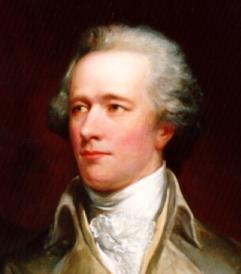Raise a Glass to Freedom and Rise Up to Hamilton's Civic Lessons
by Shawn P. Healy, PhD, Democracy Program Director
Since its smashing Broadway debut, I’ve longed to see the Tony Award-winning musical Hamilton. But I balked at the price point for tickets on the secondary market, and being the armchair historian that I am, insisted on reading Ron Chernow’s Hamilton biography first. Last week, I cleared both hurdles, and write today not wanting to “waste my shot” to translate these experiences for civics teachers and classrooms.
Having read many of the contemporary biographies of the American Founding Era, Chernow’s Alexander Hamilton ranks among the best. It’s much too lengthy for classroom use, but should be on every civics teacher’s summer reading list. Hamilton emerges as an unsung hero who never benefited from the privileges of the presidency or the opportunity to “tell his story” in retirement. Yet his contributions in the Revolutionary War, writing and ratifying the Constitution, and establishing the modern American economy cement his place alongside Washington, Adams, Jefferson, and Madison.
The musical itself is reintroducing a nation to its history, while grappling with the original sin of slavery. A racially diverse cast reflects our own students, as a majority of Illinois youth are now nonwhite, with the country as a whole close behind. And Hamilton’s immigrant heritage plays to both the American Dream of upward mobility and the barriers that remain in the forms of both explicit and implicit bias.
In this deeply divisive political era, the lessons of Hamilton resonate on two levels. First, the debates that he engaged in were every bit as vicious as todays and the press even more hyper-partisan. Under the cloak of anonymity Hamilton and his peers penned deeply personal op-ed pieces in newspapers that served primarily as party organs. True, they also touched on the issues of the day, but the insults make “Little Marco” and “Crooked Hillary” seem small.
However, these personal jousts often assumed physical dimensions in the form of duels. This, of course, is where Hamilton met his maker prematurely and thankfully duels were soon outlawed. But a sense of accountability for political discourse should carry forward, and verbal combatants must do their best to make amends for pushing the envelope too far.
Second, Hamilton left behind an infrastructure in the Constitution that establishes the formal boundaries of these debates. This includes his fierce advocacy for an independent judiciary in the Federalist Papers, and his work as a lawyer to establish that defamatory speech does not necessarily constitute libel. John Marshall was a Federalist in the Hamiltonian tradition and established the U.S. Supreme Court as a co-equal branch of government. And the “actual malice” standard for libel followed almost two centuries later.
Our government institutions are very much under attack in the contemporary era, but the divided and shared powers delineated by Madison and Hamilton will ultimately prevail assuming that we teach our students their importance and adaptability. And public discourse must be both rich and respectful. We honor our students by teaching them to deliberate across difference and simultaneously avoid the tragic fate of Hamilton and existential threats to the continuation of this ongoing experiment in democracy that he tirelessly birthed.





Comments
Post a Comment